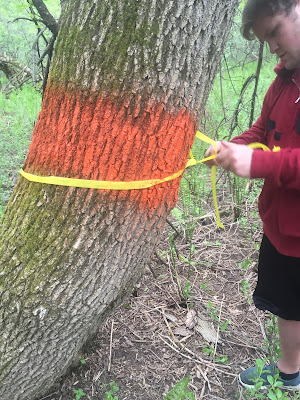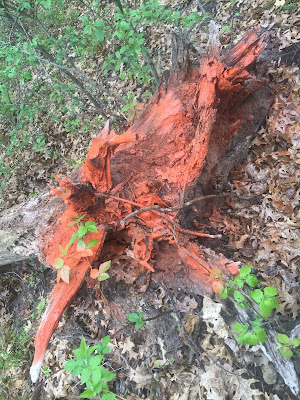Introduction
The purpose of this lab is to be able to gather a number of different variables of data including temperature (C), pH levels, and soil moisture at various points throughout the the public use gardens that are located near Eau Claire South Middle School. At each point of data collection a flag was put in and a GPS location was recorded. The grid system that was used was not set in stone and it was made by the class, the goal was to learn how to collect the data accurately more so than measuring out a uniform grid pattern. A survey grade Dual Frequency GPS was used to record data as well as take the specific coordinates of each data recording point. Throughout this lab there was a number of tools and equipment used, including the GPS, pH meter, soil thermometer, flags to mark the points, and finally distilled water to clean the pH meters between each soil sample reading. This data collection is the start of what will be a two part lab, the second part of the lab will include UAS aerial imagery.
Study Area
Figure 1 below is a number of maps that show the study area for the data collection in this exercise. The area of interest (AOI) is located to the south of the Eau Claire South Middle School, just to the north of Pine Meadow Golf Course, and to the southeast of the corner of Mitchell Avenue and Hester Street. Data collection took place on April 26th, the temperature was in the mid 40's and the rain had just ceased after the Eau Claire area got over a half inch of rain. With the exception of a few garlic plants, grass and some weeds, the majority of the community garden was rather bare, which made for muddy conditions.
 |
| Figure 1 |
Methods
The data points collected throughout this lab were done so at sub meter accuracy, using a GPS system that at time of purchase was over $12,000. Before data collection began, Proffesor Hupy demonstrated how to calibrate the pH meters, as they had just arrived that day. Next, volunteers were taken to operate the GPS unit, which has many capabilities including data records of the values collected. Next a student was selected to record the data values on paper to ensure that the data matched with the data being recorded on the GPS. Two students went ahead of the rest to place the flags in a grid pattern and to begin the data collection with the pH meter. Some groups of students used the TDR, other used the pH meter and some used the soil thermometers. Students were encouraged to try each device to become familiar with every aspect of the data collection.
One group of students operated the GPS, another used the soil thermometer, and two groups of students recorded data using the pH meter. As stated in the introduction, there was no set in stone requirements of flag placement, but rather just a rough grid pattern. The flags were placed in semi straight lines that ran east to west, once at the west end the data collection headed back east. For the most part the flags were equal distances apart as well as the distance between rows. Some of the plots appeared to be tilled, so there was an effort to stay out of those plots. Additionally, Professor Hupy has garlic plants planted on the north side of the plot in the middle, and he wanted a few readings in the plots to see the overall soil quality of the area near his plants, this explains the north side row of data collection.
 |
| Figure 2 |
 |
| Figure 3 |
Figure 2, above left shows a close up of the survey grade GPS that was used to obtain sub centimeter accuracy for this lab. The device is not hard to use, but there is a large amount of settings and useful features that do take some time to become comfortable with. This was the longest data recording process of the day, as the user needs to navigate to a few different screens at each data collection point. Figure 3 to the left shows Professor Joesph Hupy showing students how to use the GPS. The survey grade GPS was used to get a coordinate at sub centimeter accuracy, after the location was recorded the group operating the device also had to enter in the temperature, soil moisture and pH for that point. The data recorder is pictured on the left side of figure 3, and he was responsible for recording all the data and conveying it to the group entering it into the GPS system.
 |
| Figure 4 |
 |
| Figure 5 |
Figure 4, displayed above shows a student taking a temperature reading of the soil. The device takes a temperature reading by simply sticking the metal end of the device into the ground and letting the temperature became consistent at one number. Between each temperature reading a simple wipe of the stick to remove previous soil was all that was required. A few times this device took some time to get a reading, whereas when it was in the air and not in soil it would always register. When the device would display an error message the pH meter was used to record the temperature for that point. Figure 5 above right shows the collection process for the pH meter. A soil sample was taken in the small plastic container and distilled water was added to the tube, then the cover was placed on and the sample was shook in an effort to mix the water and soil so the meter could get a reading. The readings took about 30 seconds each to get a number that was not changing. After each soil collection point the meter needed to be rinsed with distilled water along with the tube used for the soil samples. Normally this process would not take to long, but the squirt bottle decided not to squirt on this day so the meter and collection tube were cleaned manually by dumping the water. This slowed the process until Professor Hupy provided an additional working squirt bottle.
 |
| Figure 6 |
 |
| Figure 7 |
Figure 6 above is a close up of the pH meters that were used. A temperature reading is displayed at the bottom of the screen and the pH value is displayed in the center of the screen. This process of data collection was very simple, though cleaning the device between each soil reading was a bit redundant. Figure 7 to the upper right shows the TDR device that was used to record the soil moisture content. This device records soil moisture by sending an pulse between the two metal conductors that go into the soil. Being that the day of data collection was very moist from all the rain received in the previous 24 hours, it would be interesting to go back another day when there was not fresh precipitation. There was only one device available for this step so three readings were taken at each flag and the average was recorded. This is in contrast to the steps taken with the pH meter, as there were two groups recording the pH to ensure data quality.
Results
 |
| Figure 8 |
 |
| Figure 9 |
Conclusion
In conclusion, the survey grade GPS unit that was used was very accurate and allowed for very precise locations of the data collection points. A number of data collection devices were used throughout this lab. In order to replicate this lab outside of the class setting, it would be very costly, as the GPS was nearly $12,000 when originally purchased. Though the unit has many capabilities, and could be used for countless other applications that could benefit an individual or company. In total data was collected for about two hours, and there was an additional set up and clean up time on top of that two hours.

















